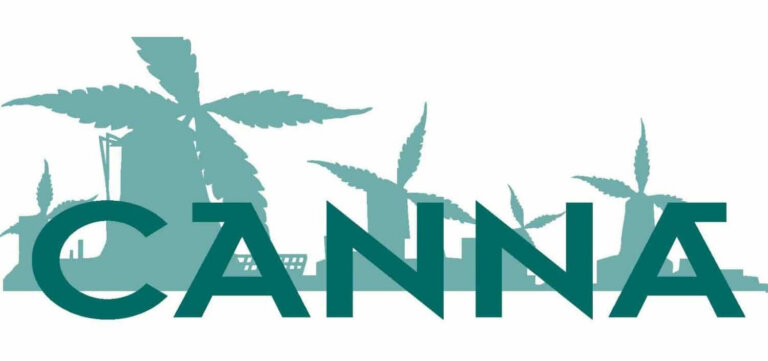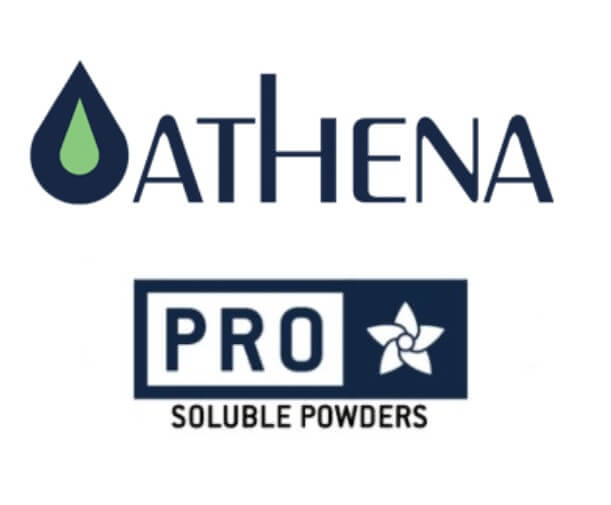How to use Metrop nutrient charts
List of contents
In recent years, the Dutch fertiliser company Metrop Hydroponics has found a place in many gardens thanks to the spectacular results that can be achieved with its products, whether cultivating indoors, outdoors or in greenhouses. The range is simple to use, as it does not have as many products as other brands, with highly concentrated fertilisers and additives suitable for all types of growing mediums, from soil or coco to hydroponic or recirculation systems such as DWC or NFT.
Thus, Metrop products are ultra-concentrated, undissolved in water and completely biodegradable, which is important for the environment. Of course, their fertilisers contain all the macro and micronutrients necessary for outstanding development, both in the growth and flowering phase. So, without further ado, let's check their products out first and then we will look at their growing charts for the most common substrates in cannabis cultivation.
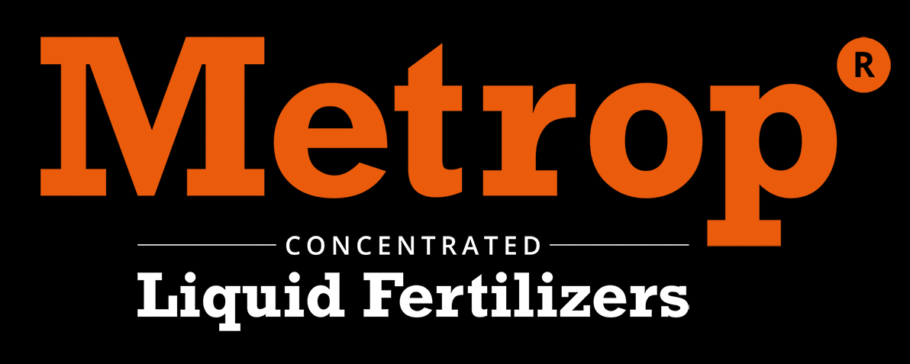
Metrop's fertiliser and supplement range
As we already mentioned, Metrop's range of fertilisers and stimulators is really easy to use, as it has been formulated in such a way that growers don't need a large number of products to achieve healthy, balanced nutrition and, above all, to get great results at harvest time. Let's take a look at each of the products and their main function before studying their cultivation charts.
Metrop principal nutrients range
- MR1 Growth: This fertiliser is formulated for the vegetative phase of plants from seeds or clones that are going to grow for a few weeks before flowering. Its NPK is 10-40-20, being very rich in phosphorus and potassium, and is used during the growth and pre-flowering of plants (the first 2-3 weeks of flowering photoperiod). Metrop MR1 is a fertilizer made from a high-quality plant extract, which is used every irrigation in nutrient-poor systems (hydroponics and coco) and every 2-3 irrigations in nutrient-rich soils.
- MR2 Flowering: In this case, we have the base fertiliser to use already in full bloom, after the stretching phase that plants undergo during the first 2-3 weeks of 12/12. With an NPK of 10-20-40, Metrop MR2 is very rich in phosphorus and especially potassium, two key elements to assure explosive flowering. It is also derived from plant extracts and is used at the same frequency as MR1, depending on the type of substrate and the nutrients contained in it.
- Root+: This is a powerful root stimulator based on a cocktail of enzymes that promotes nutrient assimilation and better plant development. With Metrop Root+ you get more roots with a greater number of capillaries, which translates into more efficient uptake of nutrients and greater resistance to stress, pests and diseases. It is usually used in all irrigations during the first 3 weeks of growth.
- Calgreen: Calcium is one of the essential elements for plants, probably the fourth most important after nitrogen (N), phosphorus (P) and potassium (K). For this reason, Metrop Calgreen has been created, a mixture of nitrogen and calcium that provides everything the plant needs to strengthen its tissues, creating denser and heavier flowers. In addition, its use prevents the appearance of fungus and rot. The frequency of use is identical to that of the base fertilisers MR1 and MR2, although it is recommended to keep an eye on the dosage if you are using hard water (with a high initial EC).
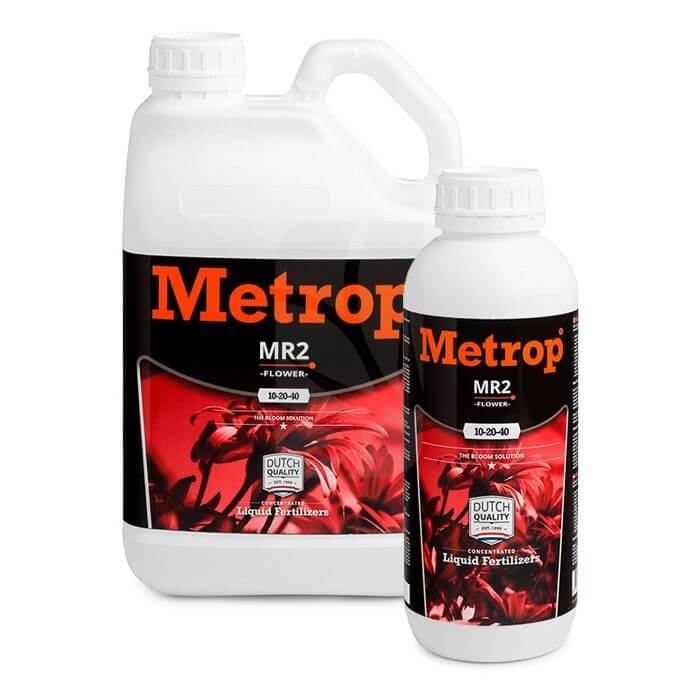
- MAM: Nutrition for mother plants, which can spend months in a vegetative state and undergo periodic pruning, is somewhat different from that of plants that will only grow for a few weeks and then flower. For this reason Metrop MAM has been created, a biomineral compound specifically formulated for the correct maintenance of mother plants. Its NPK is 20-20-8, ideal for plants that need a lot of nitrogen and phosphorus for the development of stems, leaves and roots.
- AminoXtrem: Finally, this cocktail of amino acids and vitamins is the ideal complement to Metrop's base fertilisers, providing an extra stimulus for plant growth and flowering. Metrop AminoXtrem is assimilated and acts very quickly, stimulating the production of enzymes and flowering hormones.
The Metrop range of additives and supplements
Enzymes: This biocatalyst, formulated with different enzymes, will keep our plants' roots healthy and disease-free, boosting nutrient assimilation while helping to break down dead organic matter. In this way, Metrop Enzymes ensures proper nutrition while "cleaning" the substrate of dead roots and other residues, greatly improving both growth and flowering.
RhizoXtrem: In this case, we have a plant-based stimulator designed for maximum root growth thanks to the enzymes, vitamins, phytohormones and macro and micronutrients it contains. Thanks to Metrop RhizoXtrem, the development of root capillaries is maximised, and we all know the secret that a good harvest is born in the roots of the plant!
Metrop nutrient kits
Metrop also offers various varios fertiliser and additive kits to make things easier (and more economical) for its clients. Here they are:
- Metrop Cutting Kit: Which consists of 3 specially formulated products to give a perfect start to seeds and cuttings: Metrop Substrate+, Metrop MR1 and Metrop RhizoXtrem.
- Metrop Mother Kit: This kit is specially designed for the maintenance of mother plants, including MAM, Substrate+, Enzymes, Calgreen and MR1.
- Metrop Starter Set 250ml: In this kit, we have everything you need for a grow from start to finish, in 250ml containers. The kit consists of MR1, MR2, Calgreen, Root+ and AminoXtrem.
- Metrop Start Set 1L: Like the previous kit, this one has fertilisers and additives for an entire grow, although in this case they are supplied in 1 litre containers. Includes MR1, MR2, Calgreen, AminoXtrem, Root+ and Enzymes.
How to use Metrop nutrient charts
Now that we've seen the products that we are going to use over the next few months, let's take a look at the quantities and frequency of application that Metrop recommends for each one of them, depending on the growing medium being used. Metrop offers 3 different charts: one for the main range of nutrients and valid for soil, coco and hydroponic systems without recirculation. The second is for additives, while the third chart is dedicated to systems such as DWC or NFT, where there is recirculation or reuse of the nutrient solution (the water with the nutrients returns to the tank after escaping through the drainage of the irrigation system, being reused). In addition, we will also see that their fertiliser for mother plants, MAM, has its own chart.
As usual, we have the weeks of vegetative growth (18 hours of light) and flowering (12 hours of light) on the left-hand side of the chart, while on the right-hand side, we find each of the products used with their corresponding dosage for each week. As you can see, Metrop has used a 10-week flowering period as a reference, with a final week of flushing in which only AminoXtrem and Enzymes are used. When growing varieties with shorter flowering periods, we only need to adapt the chart by removing weeks from the end of the chart, although always remembering that last final week of flushing.
*Important: Calgreen must be added to the deposit after mixing the rest of the products, never beforehand.
Metrop nutrient chart

As we can see, Metrop offers products and charts that are easy to use due to their easy dosage and small amounts of products. However, don't be fooled, the results are great! The first thing we see is that during the growth phase we should use MR1, Root+, AminoXtrem and Calgreen. Once flowering has begun, we continue with this same nutrition during the pre-flowering phase (the first 2-3 weeks of the flowering photoperiod). At the end of this phase, we stop using Root+ and replace MR1 with MR2, the base fertiliser for this stage, a nutrient regime that we continue until the start of final root flushing (last week), where we water only with AminoXtrem. This chart is designed for soil, coco and hydroponic systems without recirculation.
Metrop DWC nutrient chart
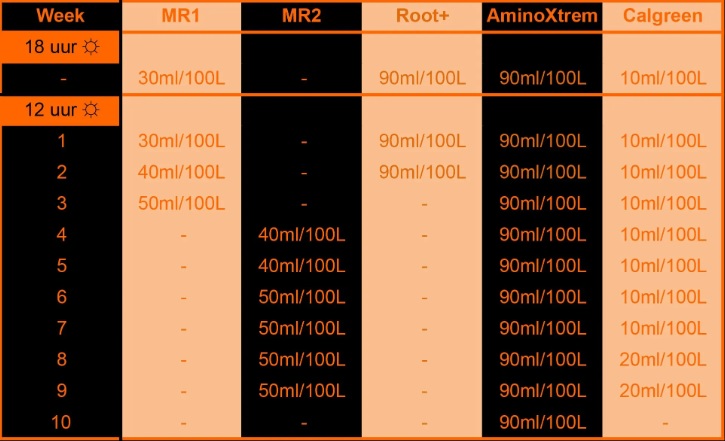
The chart for DWC cultivation or recirculating hydroponic systems is practically identical to the previous one. We use the same products, although in this case, the dosages vary slightly. Once again, the last week of flushing is respected by watering only with AminoXtrem.
Metrop additive chart
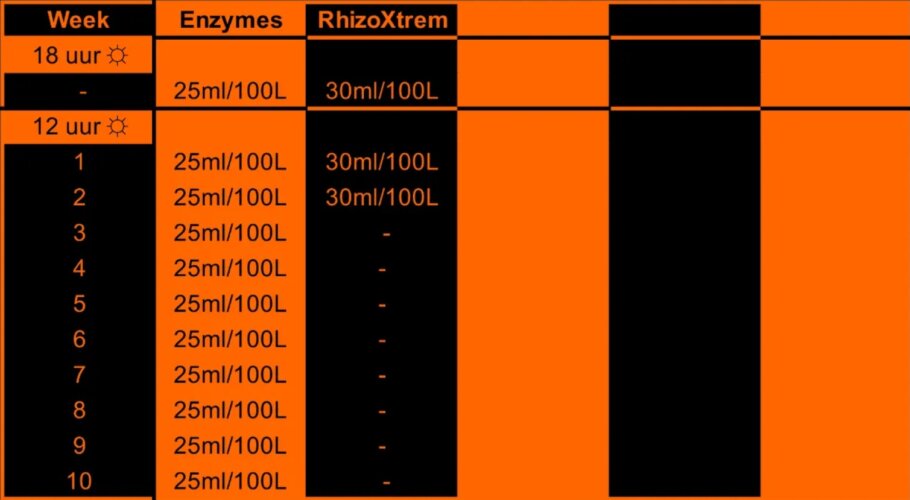
Metrop nos presenta una tabla a parte con sus aditivos, Enzymes y RhizoXtrem. Como vemos, el primero deberá usarse durante todo el cultivo, desde la primera a la última semana de cultivo (incluyendo la semana de lavado final). En cambio, el uso de RhizoXtrem se limita a las fases de crecimiento y prefloración.
Metrop presents a separate table for its additives, Enzymes and RhizoXtrem. As we can see, the former should be used throughout the entire grow, from the first to the last week of cultivation (including the final week of flushing). On the other hand, the use of RhizoXtrem is limited to the growth and pre-flowering phases.
Metrop MAM chart
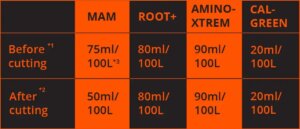
Finally, Metrop provides a chart for the maintenance of mother plants, including MAM, Root+, AminoXtrem and Calgreen. As we can see, the doses vary depending on whether we are dealing with normal plant growth or if we intend to take cuttings in a few days. The difference is the amount of MAM used, which we increase slightly a few days before taking the clones from the mother plant.
So that's our summary of Metrop nutrition products and charts. As we have seen, it is a comprehensive range of nutrients and additives that are easy to use and provide amazing results that we're sure many of you have already experienced for yourselves!
Happy growing!

































































